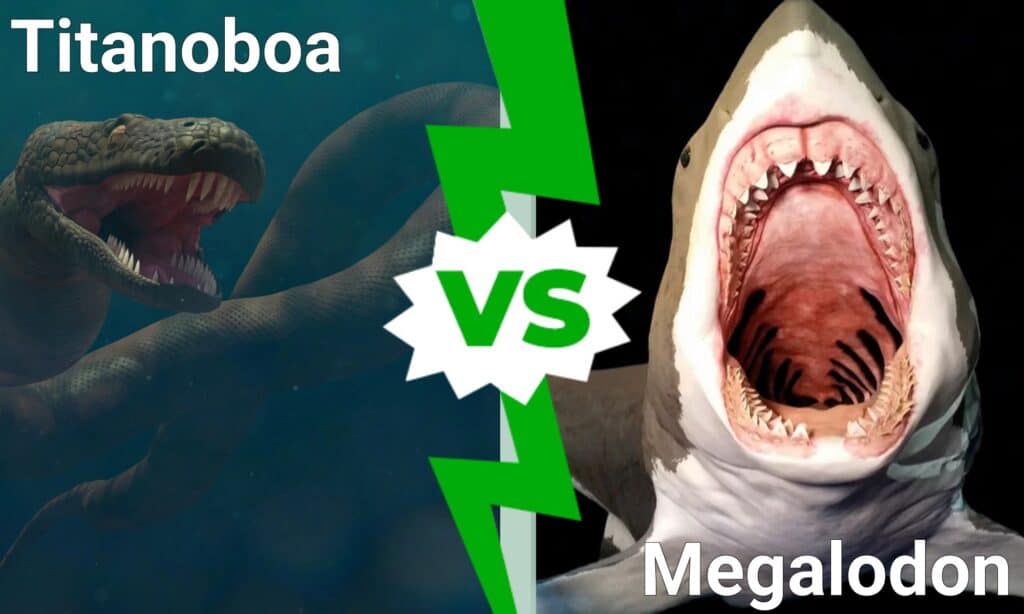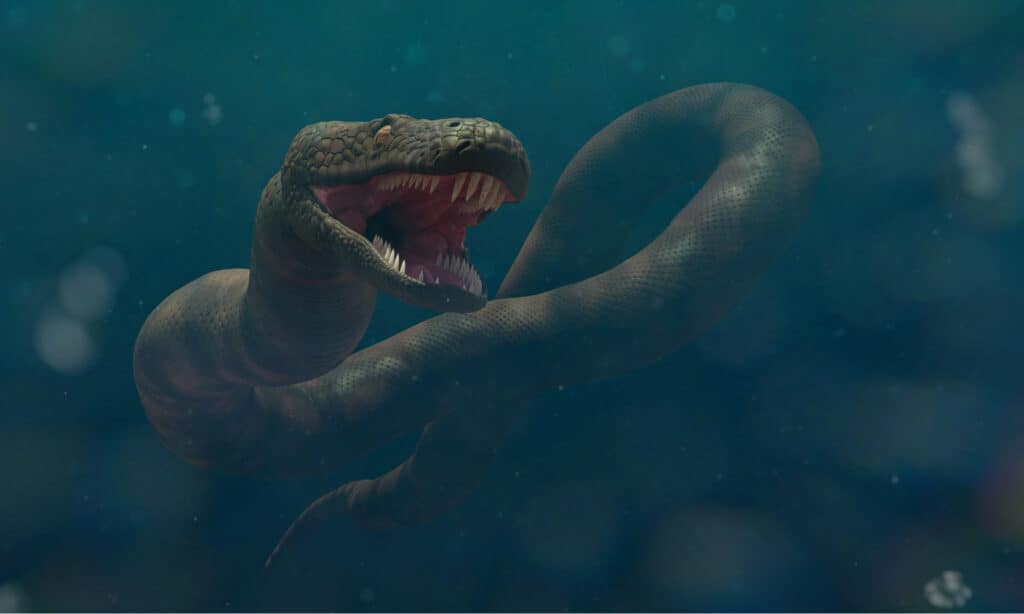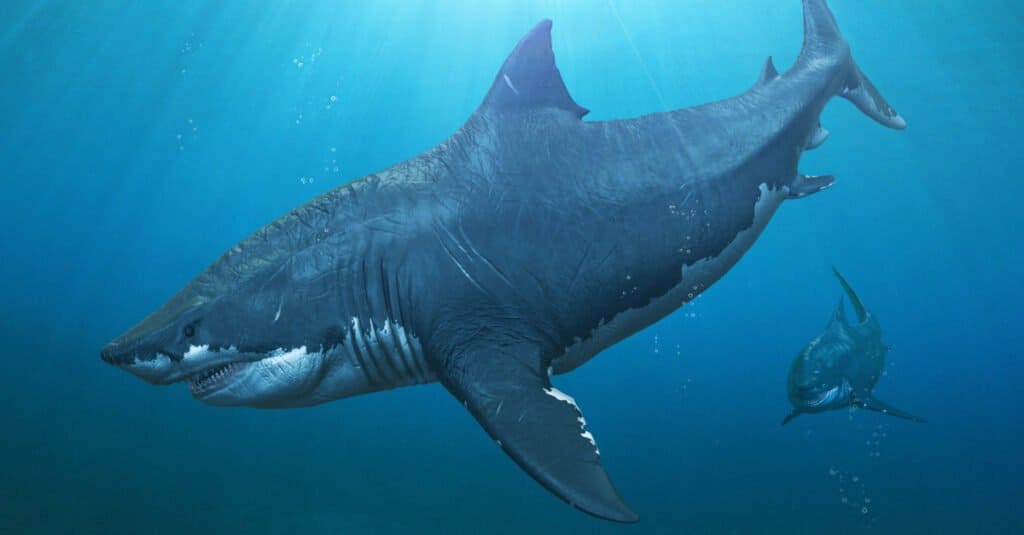Titanoboa is known as the monster snake, and it was one of the most interesting beings to roam South America about 60 million years ago. This snake was similar to the anacondas of today in that it spent its time in water and some on land. Megalodon was the largest shark to ever live, and it lived until about 2.6 million years ago. Although these two creatures are separated by time, it’s interesting to wonder about what would happen if they met in the water. Let’s examine a hypothetical Titanoboa vs Megalodon match and see which of these terrifying creatures of the deep would win a battle!
Comparing a Titanoboa and a Megalodon

| Titanoboa | Megalodon | |
|---|---|---|
| Size | Weight: 2,500lbs Length: 40-50ft | Weight: 50 tons (100,000lbs) Length: upwards of 67 feet |
| Speed and Movement Type | 10 mph (estimated from anaconda swim speed) | – 11 mph – Undulating, side-to-side motions of body and tail are used for propulsion |
| Senses | – Pit organs help identify heat from prey – Can sense vibrations from other creatures. – Uses Jacobson’s organ to smell and process chemicals | – A highly attuned sense of smell – Great vision, especially in low-light settings – Hearing is strong enough to hear splashing prey – Ampullae of Lorenzini helped detect living creatures. |
| Defenses | – Large size – Camouflage from its skin color | – Massive size – Speed |
| Offensive Capabilities | – Possessed several rows of teeth on upper and lower jaws to prevent prey from escaping – Ability to constrict and crush prey | – Jaws exceeding 6.5 feet in diameter, possibly 9 feet. – 250 teeth, about 7-inches long each – Bite exceeding 108,000N – High swim speed |
| Predatory Behavior | – Likely an ambush predator | – Stealthy predatory that ambushed prey |
What Are Key Differences Between a Titanoboa and a Megalodon?

Megalodon was a massive
shark
with a devastating bite
©Gil Cohiba/Shutterstock.com
The biggest differences between a Titanoboa and a Megalodon include their morphology and size. Titanoboa was a very large snake creature that weighed 2,500lbs and measured 50ft long, and megalodon was a massive shark that weighed up to 100,000lbs and measured 67ft long.
Their bodies were highly dissimilar, as were their ranges. Megalodons lived in waters all over the world except for the poles, but Titanoboa was only found in South America.
These differences along with other information will help us determine which animal has the edge in a fight. We just need to narrow down which factors are most important in that regard.
What Are the Key Factors in a Fight Between a Titanoboa and a Megalodon?

A titanoboa compared to a human shows how large they were
©Michael Rosskothen/Shutterstock.com
The most important factors to examine in a fight between Titanoboa and Megalodon are their size, speed, senses, defenses, and combat skills. By taking a look at each of these, we can assign advantages to the creatures and figure out which of them would win a battle.
Titanoboa vs Megalodon: Size
A megalodon is much larger than a Titanoboa, weighing 100,000lbs and growing 67 feet as opposed to the Titanoboa that only weighed 2,500lbs and grew 50ft. Although their lengths are similar, the sheer size and thickness of the megalodon make it a far larger being.
Megalodon has the advantage in size.
Titanoboa vs Megalodon: Speed and Movement

Titanoboa spent much of its time in the water
©Dotted Yeti/Shutterstock.com
The Megalodon was faster than the Titanoboa in the water, but it would be a close race between the two. It’s believed that the megalodon could swim at 11 mph and the Titanoboa could swim at about 10 mph. However, it’s hard to say how fast creatures that large could swim, but these estimates favor the Megalodon.
The Megalodon has a very slight advantage against the Titanoboa.
Titanoboa vs Megalodon: Senses
The Megalodon was a hunting machine with amazing senses. For example, this creature had a very high sense of smell much like the modern-day great white shark. That means they can detect 1 part per billion chemicals in the water.
Their vision was great in the day and the night, and their hearing is so good that they can sense something splashing around in the water far above them. Lastly, they have a sixth sense in their ampullae of Lorenzini that allows them to detect electrical fields of prey. Nothing is sneaking up on them.
The Titanoboa had pit organs to help them identify heat coming off of other animals. Moreover, it could sense vibrations in its immediate area while also having a powerful sense of smell. Like modern snakes, they could flick their tongues out to taste the air or water and learn about their environment and the creatures in it.
Megalodon had far better senses than the Titanoboa, but the snake was still equipped to hunt.
Titanoboa vs Megalodon: Physical Defenses
Both the Titanoboa and the Megalodon used their large sizes to scare off predators. Of course, this worked best when the animals were fully grown. The Titanoboa could also rely on its ability to swim in the water and slither on land to get away from some predators while also blending into its environment.
Titanoboa had more physical defenses that the Megalodon, but they weren’t much better.
Titanoboa vs Megalodon: Combat Skills
Like modern sharks, the Megalodon would stalk its prey and then attack from underneath with a devastating ambush. With one bite, it could drive its 7-inch teeth into its foe, tearing massive amounts of flesh away and leaving the animal to bleed out. Their bite power was like nothing we know of today, and their jaws were as big as 9 feet in diameter. That’s about three times the diameter of the Titanoboa.
The Titanoboa was also an ambush predator. This animal would stalk its prey and then latch onto it with its teeth while wrapping its body around the foe. Once Titanoboa had wrapped around the animal several times, it would constrict and squeeze the prey to death, breaking bones and causing organ failure.
Who Would Win in a Fight Between a Titanoboa and a Megalodon?

Megalodon is far too powerful and comfortable in the water to lose a battle to Titanoboa
©Herschel Hoffmeyer/Shutterstock.com
Megalodon would win a fight against Titanoboa. The monster snake is a one-trick pony, and that trick isn’t any good against a massive shark. Even if it managed to wrap about the shark, it’s much too small to kill it.
Megalodon was about 9 feet across and weighed 100,000lbs. Wrapping and constricting that sort of creature would require a mythical snake, not just a very large one. Meanwhile, the Megalodon only has to land a few bites with its massive teeth to tear away enough flesh from the snake that it would die.
In fact, Megalodon might eat the whole thing being that it weighed roughly 40 times as much! Either way, the Megalodon is going to win this fight because it would most likely land the first significant attack out of the two creatures.
Animals That Could Take Down a Megalodon
Seeing as Megalodon was the largest shark that ever lived and weighed 100,000 pounds, it would take an enormous, immensely powerful animal to bring down the Megalodon. It’s hard to believe there could be such a creature in existence that might be able to beat Megalodon in a fight, but there is one: Livyatan.
Livyatan was a giant sperm whale that weighed up to 62 tons and reached 57 feet in length (based on the size of a recovered skull) and lived in the same time period as Megalodon more than 9 million years ago.
In a battle of Livyatan vs Megalodon, the Livyatan would have the size advantage. It would also have the upper hand in terms of speed, as it’s thought the Livyatan moved at speeds similar to today’s sperm whales, reaching speeds 5-20 mph compared to the Megalodon’s 11 mph.
One area that the the Megalodon may have been superior was its extremely sensitive sense of smell, and excellent vision and hearing. Livyatan’s senses of taste and smell were not nearly as sharp.
However, ultimately in a face-off between these two ancient sea giants it’s more likely that a Livyatan would be able to take down a Megalodon, due to its size, speed, larger teeth, and endurance abilities in combat.
It’s also possible that a Megalodon could lose the fight against a pod of killer whales, which would be able to surround it and win a battle of attrition as individual killer whales took turns to bite the Megalodon until the injuries became fatal.
The photo featured at the top of this post is © Michael Rosskothen/Shutterstock.com
Thank you for reading! Have some feedback for us? Contact the AZ Animals editorial team.






